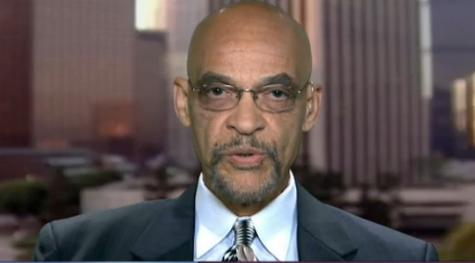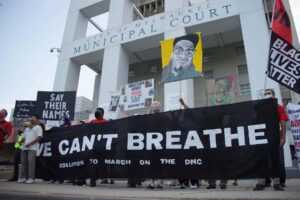Earl Ofari Hutchinson
This is the first of a two-part series examining the continued deadly use of the chokehold. It’s an excerpt from my forthcoming book The Chokehold (Middle Passage Press) release May 25 the 3rd anniversary of the Floyd slaying.
May 25, 2023, marks the third anniversary of the choking slaying of George Floyd by then Minneapolis police officer Derek Chauvin. The passage of time and the date are important for two reasons.
One, it was the month that ex-Marine Daniel Penny choked homeless, mentally challenged, Jordan Neely to death. The second was the use of the deadly chokehold. It ignited rage, anger, and a national debate once more on the use of the chokehold and the potentially deadly consequence of it. Fueling the debate and anger, the victims of the chokehold have been almost all African American men. The chokehold has every appearance of being a racially skewed lethal tactic targeting Black men.
Following the choking death of Eric Garner in 2014, some police departments publicly declared that they did not use the chokehold. They waved and cited inter-department regulation after regulation to prove that they barred the use of the hold, didn’t teach it to officers, and that many officers themselves said they wouldn’t know how to use it anyway.
That part, namely teaching the proper use of the technique, was certainly true. However, the chokehold is still in widespread use in police departments. It has many vigorous defenders. They give a litany of reasons why the chokehold is supposedly a vital weapon in law enforcement’s arsenal.
One police department, though not American, has a long and storied reputation as a model of police efficiency. That is the Royal Canadian Mounted Police. It too was concerned about the potentially deadly effect of the use of the chokehold. In June 2020, one month after Floyd’s death, the RCMP commissioned a study on the use of the chokehold.
In the meantime, it decided not to bar the use of the hold. It presented the by-then-stock reasons police officials gave for its continued use. The first was to assure that the chokehold was used only when there was the threat of grave injury, or bodily harm to the officer or someone else from an assailant.
The second reason was that the department, mindful of Chauvin’s placement of his knee on Floyd’s neck, took great pains to insist that it did not teach or endorse any technique where officers put a knee on a suspect’s neck or head.
RCMP officials were careful to state that the department used the chokehold in only a tiny number of cases. The number they cited, though, was much too small to determine if a neck restraint whether used properly or not was a safe technique to de-escalate an encounter.
It is a far different matter though with many U.S. police departments. The substantial number of lawsuits brought by victims of the chokehold against departments at various times over the years before and after Garners’ slaying show that some departments and officers do use the chokehold or a variant of it to subdue suspects.
The U.S. Supreme Court made that possible. Nearly four decades earlier in 1983, it could have ended the use of the chokehold. It didn’t. It rejected a lawsuit by Adolph Lyons, a young African American motorist, who was subjected to a chokehold by an LAPD officer following a traffic stop. The court ruled in a five to four decision against sustaining an injunction sought to bar its use. SCOTUS Justice Thurgood Marshall in his dissenting opinion was prescient in how the chokehold would cause much legal mischief in the decades to come.
“Since no one can show that he will be choked in the future, no one – not even a person who, like Lyons, has almost been choked to death – has standing to challenge the continuation of the policy. The city is free to continue the policy indefinitely, as long as it is willing to pay damages for the injuries and deaths that result.”
Erwin Chemerinsky, the dean of the School of Law at the University of California, Berkeley agreed. In his book, Presumed Guilty: How the
Supreme Court Empowered the Police and Subverted Civil Rights, proved Marshall more than correct. He noted, “To give one example: George Floyd died in Minneapolis from police use of the chokehold. Eric Garner died in New York City from police use of a chokehold. Many others, especially Black men, have died from police use of the chokehold. One would wonder: Why hasn’t the Supreme Court said that the chokehold violates the Constitution, that there have been lawsuits trying to enjoin police use of the chokehold?”
This is the question that remains both puzzling, frustrating, and largely unanswered on the issue of police reform. It’s a question, sadly, that the SCOTUS and other courts have answered with their rulings and decisions to permit the continued use of the chokehold. It’s a question, equally sadly answered by many police departments in the U.S. that refuse to bar the use of the chokehold. In the meantime, the Floyds and Neely’s continue to be the victims of its use.
Earl Ofari Hutchinson is an author and political analyst. His forthcoming book, The Chokehold (Monthly Review Press). He is the host of the weekly Earl Ofari Hutchinson Show on KPFK-Radio 9 AM Saturdays and the Pacifica Network. He is the publisher of thehutchinsonreport.net

